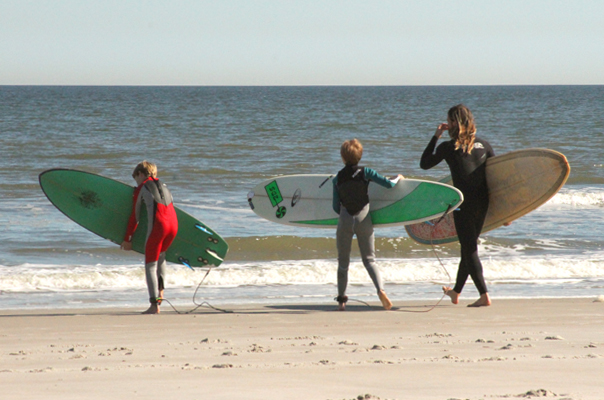Fernandina Beach, FL has some of the most dramatic seasonal shifts in air and water temperatures that I know of. I’m not saying that it get’s particularly cold, just that temps vary widely. In Southern California there is a distinct summer and winter outside but the water temps seem to hover in the 60’s (Fahrenheit) occasionally dipping into the high 50’s or rising into the low 70’s. In a typical year on Amelia Island you can experience everything from water in the low 50’s to brief foray’s into the mid 80’s. This makes it hard to keep the right temperature rated surf wax on your board. It also means that the decision of whether or not you are going to surf through those first few winters becomes a decision about whether or not you want to invest in a decent wetsuit.

This is an even bigger problem for young kids who are still growing. Wetsuits aren’t something you want to “grow into.” A wetsuit that is even just a little too big can take on cold water faster than your body can warm it up, getting flushed everytime you duckdive for instance. A properly fitting wetsuit lets in and retains a small amount of water that is then warmed by your body heat. It will cycle small amounts of water at the neck and cuffs but this should never dramatically reduce the overall temperature of the water the suit has taken in. A little too tight is better than a little loose and kids who might be spending only one season in their suits might look to participate in a hand me down cycle to surf through those early winters.

After fit one of the most important considerations is thickness. Anyone who has been surfing for more than a decade has usually experienced some level of astonishment at how flexible and light neoprene has become. Today’s 4 mm is just as stretchy as yesterdays 3mm. A suit’s thickness is recorded with two numbers, 3:2 or 4:3 for example, where the numbers are thickness in millimeters. It’s a little different for each suit but the smaller number usually represents the panels of the wetsuit that need more flexibility like the ones used in paddling. Your traditional performance wetsuit is a 3:2. However, I’ve chosen to go a little thicker (4:3) in hopes of getting away without having to wear accessories like booties, gloves or a hood. I also hope to get an extra season or two out of my suit since it feels like a little too much for all but the coldest handful of days (or weeks during the harsher winters). I will say that my first session back in the 4:3 after putting it away for the summer is a tough one even with the advances in materials.

Everyone has different tolerance levels for cold water but my general comfort is as below (Fahrenheit):
High 70’s and above – I’m skinning it
Low to Mid 70’s – Skinning it if the weather is nice, springsuit if the weather is cool.
Mid to high 60’s – Springsuit if the weather is nice, fullsuit if the weather is cool.
Low 60’s and below – Fullsuit
These are for comfortable multi hour sessions. If I know I’ll only be out for an hour I can go a little lower on everything (skin it in the high 60’s for example). The closest to realtime estimate for our shoreline water temperatures can be found at the National Data Buoy Center’s Fernandina Buoy Station 41112.